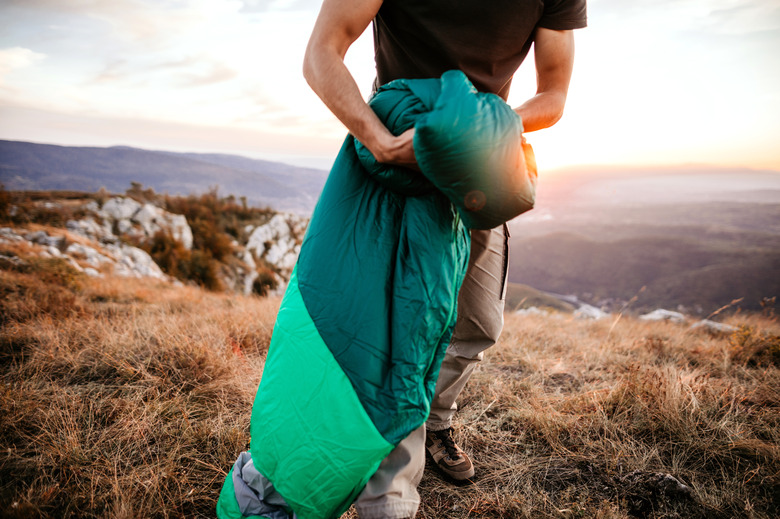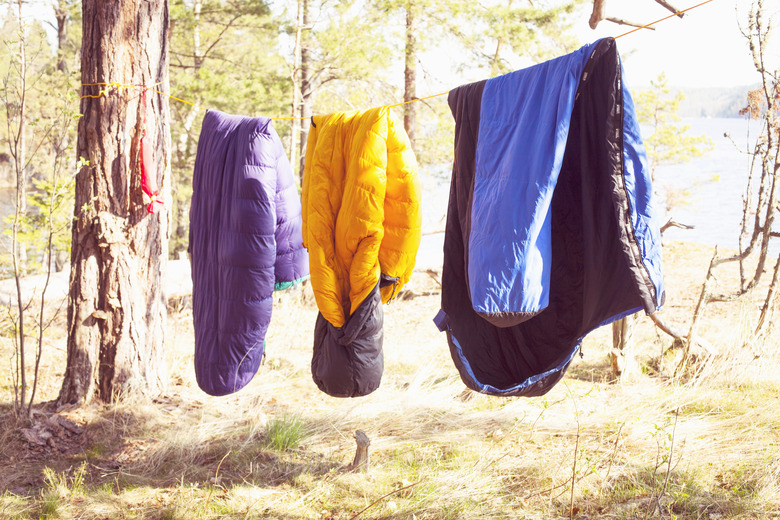How To Wash A Sleeping Bag
Whether you use your sleeping bag mostly for indoor overnighters or for outdoor camping adventures, sooner or later that bag needs a thorough washing. Much like winter coats, the fabric and fill materials vary from one bag to the next, so they can't all be cleaned the same way. The care tag on the sleeping bag offers you the first clues on the best way to ensure your bag stays in the best shape possible, no matter how often you use or wash it.
Shake It Out
Shake It Out
Before rolling up that sleeping bag after use, shake it out to remove any debris, loose dirt or bugs that may be on or in it. If possible, also air the bag out by hanging it over a clothesline or tree branch on for a while on a dry day. If the weather isn't cooperative when you are ready to leave a campsite, air the bag out at home over a chair, instead. This helps remove odors such as campfire smoke.
Look for a Materials Tag
Look for a Materials Tag
If your sleeping bag feels lumpy in places, smells bad or visibly needs a washing, look for a tag stitched onto it before throwing it into the washing machine. There may be two tags—one to indicate what fill material is used in the bag, such as down feathers or synthetic fibers, and another tag that states the best way to wash the bag in a machine. Follow these washing instructions, if they are present, Otherwise, use a detergent made for down-filled goods if you have a down-filled sleeping bag, or a detergent for delicates if you are washing a sleeping bag with synthetic filling.
Find a Front-Loading Machine
Find a Front-Loading Machine
Unless you're washing a tiny sleeping bag designed for toddlers, chances are the sleeping bag is too large for the washing machine you have at home. Commercial washing machines found at laundromats are large enough to wash even the biggest sleeping bags. Choose a front-loading machine, not a top-loader, which has an agitator that can twist, tear or otherwise damage a sleeping bag.
Select a warm-water setting and extra rinse and spin cycles, then add the appropriate detergent before starting the machine. If the bag still feels full of water after its final spin cycle, put it back in for another spin, if possible, to cut down on the drying time. Gently roll the sleeping bag over a sink to help release any remaining moisture.
Avoid Dry Cleaning
Avoid Dry Cleaning
Even though dry cleaning seems convenient, it's not good for a sleeping bag. The chemicals and solvents used by many dry cleaners may stay in the fibers of the bag or even damage it. These chemicals are also toxic, in some cases. Organic dry cleaning may be an option, but consult the bag's manufacturer for assurance before trying this.
If You Must Hand-Wash
If You Must Hand-Wash
Hand-washing a sleeping bag isn't ideal, as it's time-consuming and somewhat messy. If the care tag indicates hand-wash only, place it in a clean bathtub or a utility sink, along with warm or cool water, following the care tag's recommendations. Add a small amount of the appropriate detergent for down or delicates.
Swish the bag around in the water with your hands, gently squeezing at times to work the water through the filling. If the bag has areas of heavy soil, place the soap directly on those areas and rub the sleeping bag with another part of the bag.
Allow the bag to soak for 30 minutes or longer, then drain the tub, refill it with cool water, then squeeze the bag beneath the water several times to rinse it. Drain the water again and squeeze the bag to remove as much remaining water as possible. If you see soap as you squeeze, rinse the bag again, as needed, until no more soap remains.
Drain the tub a final time, press down on the bag to release the water, then cart the bag to a dryer or clothesline. Do not wring the bag, as this could damage it.
Drying a Sleeping Bag
Drying a Sleeping Bag
Most sleeping bags can be dried in a clothes dryer. Select a low-heat setting and the longest drying time available, then toss the bag into the dryer, If the bag has down filling, add a few clean tennis balls or wool dryer balls to help re-fluff the fibers. Do not use fabric softening sheets or dryer sheets containing fabric softener, as these leave behind a residue that could damage the bag or make it more difficult to clean in the future.
Start the dryer, then check it after 20 minutes or so to check the progress and ensure the dryer isn't overheating the sleeping bag. This shouldn't be a problem, so long as the dryer is functioning properly. If possible, conclude by partially air-drying the sleeping bag on a clothesline, out of direct sunlight.
Keeping the Bag Clean
Keeping the Bag Clean
Since washing a sleeping bag can be a bit of a hassle, do your best to keep it relatively clean while you use it. Don't wear the day's hiking clothes to bed when out at a campsite, as whatever dirt and debris soil that is in your clothing can also make a mess of the sleeping bag. Slip into clean garments before crawling into your sleeping bag for the night. A sleeping bag liner is another excellent option, especially for a down-filled bag. This keeps the inside of your bag stays nice clean even if you aren't.
Use a pad beneath your sleeping bag instead of setting the bag directly on the ground. A pad protects the bag from snags and dirt while offering a bit of insulation and padding beneath your body.
A sleeping bag can also be spot-cleaned when necessary. The area where your head rests is particularly susceptible to hair oils and dirt. To clean this area, first, gently wet the affected spot, pulling the shell away from the fibers, since the shell is the area that's dirty. Then, apply a dab of a detergent designed for delicates, and scrub it with an old toothbrush or a fingernail brush. Rinse the soap off, again doing your best to wet only the bag's shell. Allow the bag to air dry.




